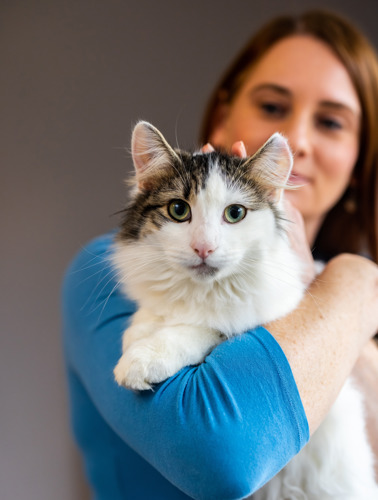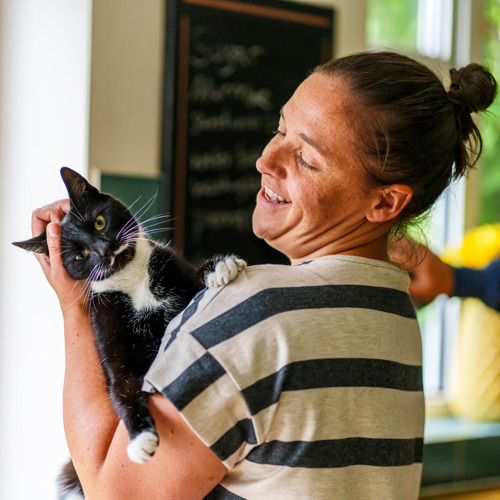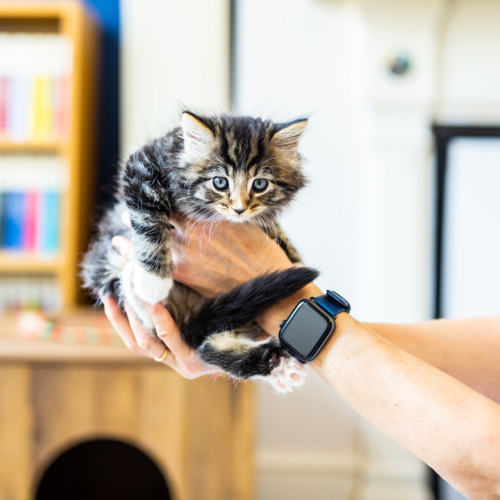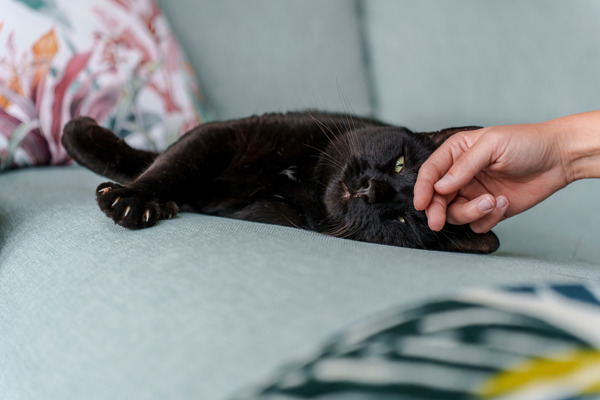Discover how to properly pick up and hold a cat or kitten with our step-by-step guide
Every cat is an individual. While some cats will enjoy being picked up and held, many cats don’t enjoy being restrained in this way.

While it can be very tempting to want to pick up and cuddle your cat, it’s important to learn what they are comfortable with. Respect their boundaries if they don’t want to be held. Keeping any interactions on their terms is the best way to gain their trust and form a close bond with them.
Follow our step-by-step guide below to learn how to pick up your cat safely and keep them happy in the process.
Do cats like being picked up?
Cats are usually most comfortable when they have all four paws on the ground, Then they know that they can run away to safety if they feel scared or threatened. Being picked up and restrained takes away their choice in their surroundings. It can make them feel vulnerable and stressed. They will usually be much happier interacting with you when they have the option to move away if they want to.
There will be some cats who are the exception to this and will enjoy being picked up and cuddled by their owners. Whether they like being picked up or not will usually depend on the cat’s past experiences. If the cat was handled appropriately as a kitten, during their important socialisation period when they were two to seven weeks old, they are more likely to be comfortable with being picked up as an adult. But if they’ve had negative experiences with being picked up in the past, such as being held uncomfortably for long periods of time, they may have learned to find being handled stressful.
The best way to find out if an individual cat is comfortable with being picked up is to take things slowly. Try fussing or stroking them first. Pay attention to their body language and behaviour to see how they like to be handled. Some cats don’t like being picked up and that’s completely normal. Luckily there are lots of other ways you can show them some love, such as playing with them or petting them. Find out how to play with your cat and how to pet your cat.
How to pick up a cat

If you want to pick up a cat, follow our step-by-step guide for picking them up safely. If you need to pick them up urgently, for example to move them away from danger, and it’s safe for you to do so, you can skip to step five. Make sure you put them back down as soon as you’ve moved them to safety.
- Approach slowly and on their level. Cats don’t like surprises, so avoid sneaking up on them. Don’t try to pick them up when they are sleeping or hiding. Move slowly and get to their level so you are not looming over them, as this could be scary for them. Stay a short distance away from them and keep quiet or speak to them at a low volume. Make sure you’re not cornering them and that they can get away from you if they want to.
- Hold out your hand. Slowly hold your hand out towards the cat and keep it still. If the cat wants to interact with you, they will approach your hand and maybe give it a sniff. If the cat does not approach you after a minute or two, they do not want to be touched or picked up. Don’t force interactions with a cat. This could cause them stress and negatively affect their bond with you.
- Stroke their face. If the cat has approached your hand, you can try to gently stroke or tickle their cheeks or chin. These are areas that most cats like being touched. Always move your fingers in the direction of their fur.
- Pay attention. While stroking the cat, pay close attention to their body language and behaviour. Look at our cat body language guide to find out what signs to look for. If they do not move away and they have happy and relaxed body language, they are enjoying the interaction. You can continue petting them and then pick them up. If they do not move away but have anxious or stressed body language, they are only tolerating the interaction. They are not enjoying it. Stop petting them and do not pick them up. If the cat moves away, don’t follow them and don’t try picking them up. If the cat tries to attack or bite your hand, try to stay calm. Slowly move your hand away from them and do not try to pick them up. Find out what to do when a cat bites you.
- Pick them up. If the cat has not moved away and their body language is happy and relaxed, you can then try picking them up. While bending down next to them, stroke your hand down the top of their back. Then move it to under their chest, behind their front legs. Put your other hand behind their back legs. Gently scoop them up so you are supporting their rear end in the crook of our elbow. Don’t leave their back legs dangling down.
- Hold them securely. As you stand up, bring them close to your chest and hold them securely. Make sure their rear end is supported with one arm while your other arm is wrapped around their chest and supporting their front legs. They may want to rest their front paws on your arm or shoulder. Try to stand or sit still while you hold them. If you do need to move around, do so slowly and carefully.
- Know when to put them down. If the cat remains calm with relaxed body language then you can continue holding them. Most cats will only be comfortable being held for a minute or two at a time. If they start to wriggle around, look stressed, hiss, growl or try to attack or bite you then it’s time to put them down.
- Lower them gently. When you put the cat back down, continue holding them securely as you slowly lower them to the floor. Once they are close to the ground allow them to put all four paws down and then let them go. Try to avoid letting them jump from your arms as they may scratch you with their claws as they do so.
How to pick up a kitten

When picking up a kitten you should follow the same steps above. Although kittens are smaller they should still be picked up with two hands. They should have their rear end properly supported. If they are small enough, you can support their rear end with your hand instead of your arm or elbow.
How to pick up a nervous cat
If the cat you are trying to pick up is particularly nervous, for example they are reluctant to approach you or showing anxious or stressed body language, then you should avoid picking them up. Only pick them up if it is urgent, for example you need to move them from danger. Picking up and holding a nervous cat that does not like handling is stressful for them. It's also not the best strategy to get them comfortable with handling. If you need to pick them up to get them into a cat carrier to take them to the vets, it’s better to train them to get into the cat carrier by themselves if you can. Find out how to train your cat to use a cat carrier.
If they are still nervous of getting into the cat carrier, you can use this technique in the short term or in an emergency:
- Holding up a blanket or towel with two hands, calmly approach the cat from behind.
- In one quick movement, place the blanket over the cat, covering their entire body and head.
- Firmly but gently place your hands over the blanket on the cat’s shoulders. Then scoop them up, folding the blanket underneath them as you do so.
- Place them and the blanket in the carrier straight away.
- Cover the carrier with another blanket or towel to help keep them calm.
Is there a wrong way to pick up a cat?
Each cat will have their own individual preference for how the like to be held. The most important thing is to make sure they are fully supported at all times. Make sure their back legs are not left dangling in the air. When holding your cat, pay attention to their body language to learn what they like and don’t like. Be guided by them.
Never pick a cat up by the scruff of their neck as this is incredibly uncomfortable for them. Although mum cats sometimes pick up their kittens in this way, it’s not appropriate for humans to do so.
When should you not pick up a cat?
It’s important to keep any interactions with cats on their terms as much as possible. Try to only pick up your cat if they approach you and are willing to be handled. Only touch a cat when their body language is happy and relaxed. Avoid touching cats when:
- they are sleeping. If you try to pick up a sleeping cat you could startle them awake and scare them. It’s best to leave them to their snooze. Find out more about cats and sleep
- they are scared or stressed. If a cat is scared or stressed, it can be tempting to try and comfort them with cuddles. But picking them up is likely to stress them out more. They may even become aggressive towards you. They would much rather be left alone. Cats will often hide when they feel scared or stressed, as it helps them to feel safe. Don’t disturb them if they are hiding. Instead, try to work out what is causing them stress and resolve the problem. Find out more about cat stress, including how to recognise the signs
- they are in pain. If a cat is in pain, touching them or picking them up could make the pain worse. Cats are good at hiding their pain, so it might not be obvious that something is wrong before you touch them. Find out how to spot the signs of pain in your cat
- they are hunting or playing. When a cat is feeling playful or hunting their toys, they can get very excited. If you try to pick them up while they are playing, they may mistake your hand for a toy and bite or scratch you. It’s best to keep your hands away from cats when they are playing. Instead use toys such as fishing rod toys or ping-pong balls that you can use from a safe distance. Find out how to play with your cat
Why does my cat bite me when I try to pick them up?
If a cat bites you when you pick them up this is a definite sign that they do not want to be held. Cats will usually run away and hide if they are feeling scared or stressed. But if you are holding on to them then they do not have this option. They may become aggressive to let you know they want to be left alone. If a cat tries to attack or bite you when you pick them up, try to stay calm and put them back down gently. Then give them plenty of space and allow them to run away and hide if they want to. Find out more about why cats bite and how you can stop a cat from biting you.
How to train a cat to be picked up
The best way to teach a cat to be comfortable with being picked up is to introduce them to this type of interaction during their socialisation period, when they are two to seven weeks old. This is when their brain is still developing. Gently introducing them to new sensations such as being picked up by humans will help them learn that these interactions are positive and not scary. Find out how to socialise a kitten.
If you want to teach a cat older than seven weeks old to be comfortable with being picked up, it’s important to consider your reasons why. If it’s so that you can handle them more easily to groom them or give them medication which will benefit the cat, then this is possible. Cats can be trained to be comfortable with handling in certain situations, but they may still not enjoy it. Find out how to train your cat to be comfortable with handling.
If you want to train your cat to be picked up and put in a cat carrier for a trip to the vets, it’s much more effective to train them to get into the cat carrier by themselves. Find out how to train your cat to use a cat carrier.
If you want to train your cat to enjoy being picked up for your own benefit, because you will enjoy cuddling them, this is not recommended. Training a cat to be comfortable with being picked up will only work for specific situations. The cat is still unlikely to enjoy being randomly picked up whenever you want to hold them. The good news is that there are other ways you can bond with your cat that don’t involve cuddling them. If your cat is comfortable with some interaction you can try petting them with head rubs and tickles on the chin. Find out how to pet a cat. Playing with your cat is also a great activity that both of you can enjoy. Catching toys releases feel-good hormones in a cat’s brain. Plus, you will have fun watching them stalk, pounce and chase their toys. Find out how to play with your cat.



